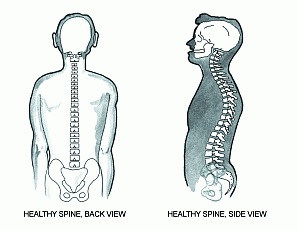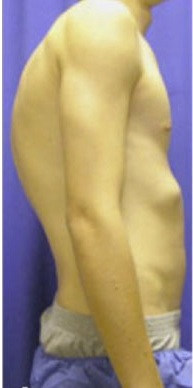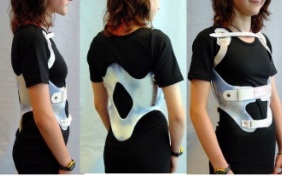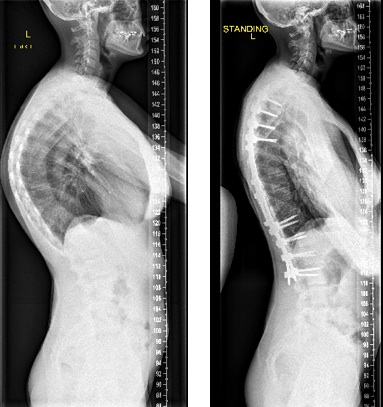- Home
- Patient Area
- Kyphosis
What is kyphosis?

A normal spine is straight when viewed from in front and has a gentle S shaped curve when viewed from the side. There is an arching forwards in the neck and lower back (lumbar spine) which is called a lordosis. The thoracic spine (the section between the shoulder blades) has a curve backwards naturally, this is known as kyphosis.
When we talk about kyphosis as a problem, we mean it is more curved backward than it should be in the thoracic spine. Alternatively, it could mean that there is less arching forwards than there should be in the neck and lower back (less lordosis means increased kyphosis).
A kyphosis in the thoracic spine can make you more round shouldered and unable to stand up straight. There may be pain from the discs. A kyphosis in the lower back or neck is often associated with pain or aching.
In younger patients with thoracic kyphosis, the commonest cause is Scheurmann's disorder. This is supposed to be due an inflammation in the discs during growth. It is felt that this allows the discs to narrow and the bones to become wedge shaped resulting in an increase in the kyphosis.
Other causes of kyphosis include degeneration of discs and joints of the spine (e.g. adult scoliosis), congenital bony abnormalities, fractures, infection and other rarer causes such as Hurler's syndrome.
How would I know I had a kyphosis?
It would depend on which part of the spine was affected. The following could be noticed:
- Increased round shouldered appearance
- Difficulty standing fully straight
- Pain or aching
Why does it matter?
 Mostly, a kyphosis just needs to be assessed and then observed. Most people with kyphosis do not need to have anything more than regular check ups until fully grown.
Mostly, a kyphosis just needs to be assessed and then observed. Most people with kyphosis do not need to have anything more than regular check ups until fully grown.
Sometimes the shape changes can make you feel very awkward and worried about your appearance. Some people do get very embarrassed about their shape, this is not unusual. The shape can change as you grow, particularly at the time of growth spurts.
If the kyphosis worsens, it can affect the mechanics of your spine and result in aching or pain. The pain can happen in the non affected parts of your spine (for example neck pain) as these parts of your spine try and compensate.
Kyphosis that has started as a child or teenager can go on to have wear and tear changes later in life resulting in pain or nerve pressure.
Kyphosis in the lumbar spine has more chance of being associated with pain. It is a common feature of adult scoliosis.
What should I do if I think I have a kyphosis?
Speak to your GP. Your GP will be able to examine you to see if there is a scoliosis.
If your GP is concerned, they will refer you to a Spine Surgeon, Paediatrician or Orthopaedic Surgeon at a hospital for further tests.
Once a scoliosis is confirmed, you will need to see a Spine Surgeon at a recognised spine centre who will assess you fully and talk about what you may need. The GP, Paediatrician or Orthopaedic Surgeon will refer you on to the Spine Surgeon.
Do not ignore it if you think you have a kyphosis. More often than not, it will be nothing serious and just require monitoring at the hospital. However it is important to be sure, so having someone check you properly is important.
If you have no pain, you can usually carry on with your normal activities, including sports. If you have pain, it might be better to stop sports until you are seen.
How will the doctors check if I have a kyphosis?
The first thing the GP or specialist will do is talk to you about your concerns. They will ask you questions about your health generally, how the problems are affecting you and try to get an idea how much more growth and development you have if you are not fully grown yet.
The doctors will want to examine you. They will need to examine your back, your ams and your legs, so you will need to get undressed for this. Often the hospital will give you a gown, but wearing shorts and a T shirt or sports bra may make you feel more comfortable. The examination will look at your back and see how flexible it is. They will look at your back whilst you are bent forwards as this reveals the kyphosis more (Adam’s position). Your arms and or legs will be examined to make sure the spinal cord is working normally.
The Spine Surgeon will send you for X - rays. These are necessary to see if there is a kyphosis and how bad it is. The Spine Surgeon will measure the angle of the kyphosis on the X - ray (Cobb angle).
After all of this, the doctors may want you to go for further tests such as an MRI scan.
If the plan is to monitor your kyphosis, you will be asked to return in a few months (often 6-9 months) for another examination and X - ray.
How can you treat kyphosis?
Observation
The commonest treatment plan is just to be monitored. This will be by 6-9 monthly appointments at the hospital by the Spine Surgeon. The appointment will usually involve you being examined again and having an X - ray. This is to see if your kyphosis is worsening. If it remains roughly the same each time you are seen then they will continue to monitor you until you are fully grown (between the age of 16 to 18 years old). As kyphosis often has pain associated with it, painkillers or anti-inflammatories will often be recommended. In Scheurmann's the pain often settles down but can take years to do so.
Exercise
There is no need to avoid sport or exercise when you have AIS. It is actually better for you to remain active and to have good core muscles. Unfortunately there is no strong evidence that exercise alone stops a kyphosis progressing or improves the curve. It can improve the pain from a kyphosis. There are many ongoing studies that may help prove the role of exercise one way or another.
Bracing
Sometimes a brace is suggested. Braces are usually used for milder to moderate curves. The braces are usually rigid and need to be worn 23 hours a day. They can be worn under your clothes. It has been found that braces only work if they are used more or less constantly. You can take the brace off to wash, dress and when you are doing sporting activities. Braces were not used all the time in the UK as we did not feel that most patients would wear a brace for the amount of time necessary.

A kyphosis brace
Surgery
The commonest UK operation for kyphosis is a posterior instrumented correction and fusion. This means an operation through a long scar on the back of you, to put rods and screws into the bones of your spine and straighten your spine. This operation also involves using some form of bone graft to fuse the spine to stop your curve deteriorating or coming back.
The aim of the operation is to stop things worsening and to hopefully improve your appearance. Your Spine Surgeon will talk to you about the risks and benefits of this type of an operation to you.

Example of Kyphosis Surgery
.png)